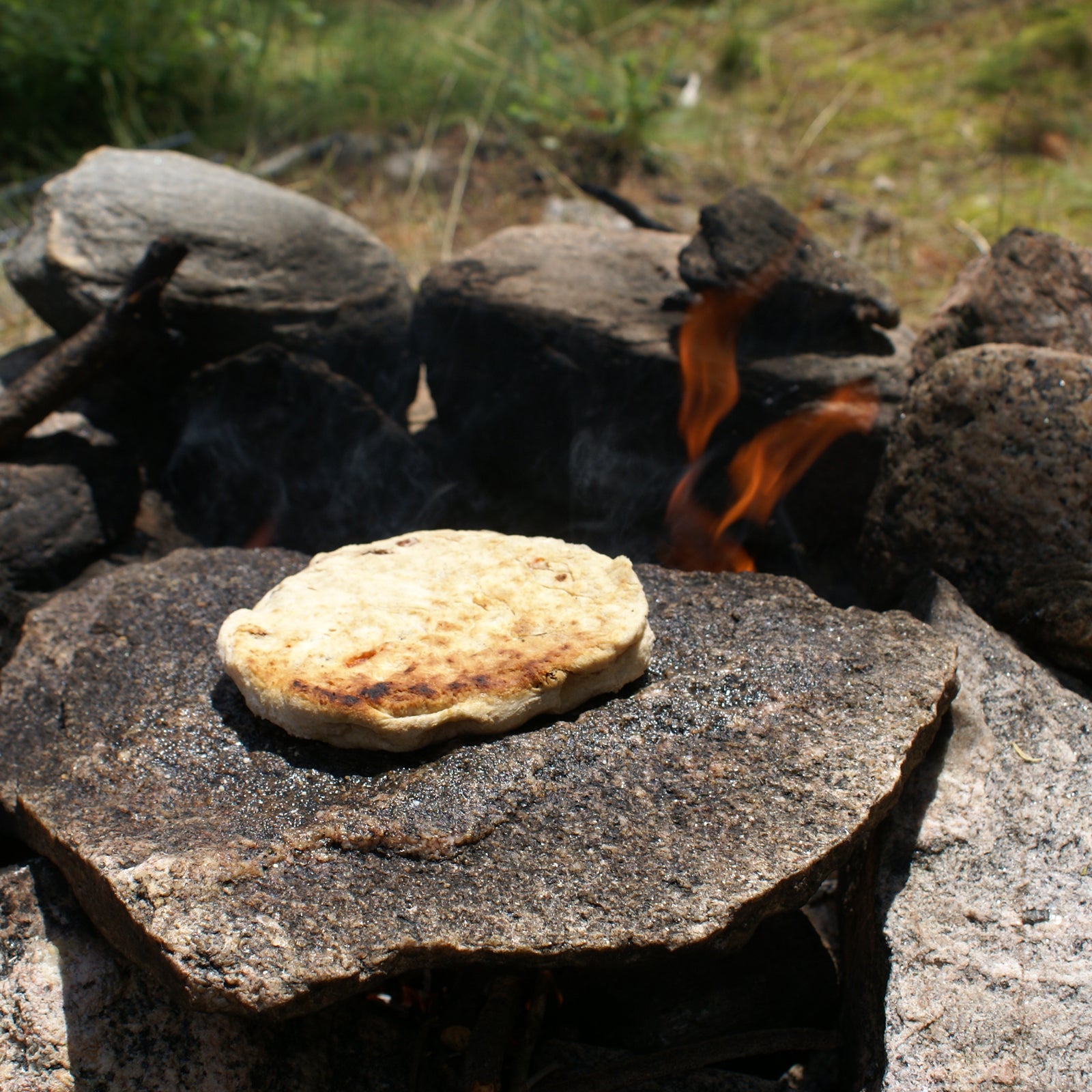Baking your buns in the backcountry may sound like a euphemism for a day with a heavy pack and 10,000 feet of elevation gain, but in this story, we mean it literally: you should be baking your buns in the backcountry.
Right now, you’re thinking, OK, but that sounds like a lot of work.
Yeah, it is more work than eating Slim Jims for 14 straight days, but it’s worth it.
“For me, being in the backcountry is about living out there and enjoying it, so you’re not on day three, fantasizing about getting back and having good food again,” says , who is based in Bozeman, Montana, and is the author of and many other outdoors-themed books. For Kesselheim, cooking time, when you and your adventure mates sit around and sip coffee as your bread bakes, is one of the most enjoyable parts of the day. “That downtime is a big part of the outdoor experience,” he says.
And the smell of freshly baked bread after you’ve torched 13,000 calories hiking? Absolutely nothing beats that, says Casey Pikla, who has been a NOLS instructor for nearly ten years. Pikla grew up baking, and since joining NOLS, he’s been working on his backcountry bread baking, including the occasional naturally leavened sourdough loaf.
Basic bread takes only four ingredients: flour, water, salt, and yeast. Sure, flour isn’t ultralight, but a pound goes a long way calorie-wise. Yeast—tiny microorganisms that leaven your bread—are alive, so you do have to treat them with care, but Pikla says they’re much heartier than you think. He’s taken them on trips where temperatures dropped to 30 below, and they somehow survived.
The only other things you need are time, a way to bake your loaf, and a tiny bit of know-how. But really that third thing is negotiable. You can fudge quite a lot, says Pikla. “Bread is actually super forgiving,” he says, adding that as long as you have more flour in your bag and more water in your Nalgene, you can fix a dough that’s too wet or too dry; it’s just a matter of adding more of either until it “feels right.” And even bad fresh bread tastes better than anything that’s been in your pack for a week. We’ve compiled three different options for the backcountry baker, starting with an easy recipe and moving up to a more complex one.
Start Here: Easy Backcountry Bannocks
The bannock is Kesselheim’s go-to carb when he’s on the move. It’s essentially a savory flatbread cooked in a pan. “You just make the dough in the field, throw it in a fry pan or skillet, brown it on both sides, and when you’re done, you have something that looks kind of like an English muffin,” he says. Because it uses baking soda and not yeast, there’s no rise time.
Kesselheim makes bags of preportioned bannock mix at home. In the backcountry, he cooks up a batch at night to go with his dinner and serve as his sandwich bread for lunch the following day. It takes just minutes to mix and fry, so there’s really no excuse not to add these to your nightly routine on the trail.
Ingredients
- 1 cup flour
- 1 teaspoon baking powder
- 1/2 teaspoon salt
- 2 to 3 tablespoons powdered milk
- Cooking oil
Instructions
Mix all of these ingredients—except for the oil—in a bag or a bowl. A bowl is slightly easier but creates one more dish to wash. Add just enough water to turn the dough into a thick batter. Start slowly with the water, because you can always add more. Stir until everything is combined and there are no lumps.
Drizzle a small amount of oil on a hot pan or a skillet over a campfire. Spoon four rounds onto the hot pan (or just two at a time if you only have a small pan). Cook for a minute or two until the bottom looks golden brown, then flip and cook until the other side is golden, too.
Level Up: Pizza Dough
Yeasted pizzas and calzones are backcountry bread version 2.0. While a leavened loaf takes a few hours to rise, pizza dough needs just an hour or so, says Ricardo Davis, a former NOLS instructor who now works in Denver as a pediatric-oncology nurse. When Davis was leading courses, he’d start the dough as soon as his group got to camp, then let it rise as everyone was setting up tents and getting settled. By the time he was ready to cook, the dough was ready to roll.
The important thing when making a yeasted dough is not to add all your flour at once. Always hold some back in case your dough ends up too wet. Most of us can filter more water if needed, but finding more flour could be tricky.
Ingredients
- 3 to 4 cups flour
- 1 teaspoon yeast
- 1 teaspoon sugar
- 1 to 2 teaspoons salt
- 2 cups water
Instructions
That’s enough flour for two to three people, and you’ll want extra just in case. You can eyeball the yeast and the salt—this is the backcountry. Sugar helps the yeast work quickly, but you can skip it if you want.
If you have extra time, in a bowl, dissolve your yeast with the teaspoon of sugar and a tablespoon or two of flour in a bit of water. Let this mixture proof (the term for activating the yeast) for a few minutes. If you’re pressed for time, skip this step. Pikla says it’s no biggie, and your dough will turn out fine.
Add your flour to the bowl, making sure to reserve at least half a cup. Then add the salt and slowly begin incorporating the water. Mix the dough with each addition of water. Begin working the dough first with a spoon, then switch to your hands as it starts to come together. If it’s super sticky, add more flour. If it’s crumbly, add more water. Spend about five minutes or so giving the bread a good knead. When it stops sticking to your hands or to the bowl, and it bounces back nicely when you poke it, it’s ready.
Find a way to cover the bowl (a plate works), and let it rise for an hour. Temperature affects rise time. If it’s cold, you’re going to need to let the dough rise in a warm place, like your jacket pocket. Your body will provide a pretty ideal rising environment, says Pikla.
You want your dough to double in size. But, you know, this is the backcountry, so don’t sweat it if it doesn’t get that big. Roll it out as best you can. Davis found that a full Nalgene and a Therm-a-Rest pad topped with a plastic bag work well for this task. Outfit your pizza as you see fit, then slip it onto a hot pan. You’ll likely want to cover the pan with a lid to get your cheese to melt and your toppings warm. Or you can use your dough for a calzone and flip it in half midway through cooking.
Level Up Even More: The Leavened Loaf
Try this on a down day or when you’re situated in one spot for a few nights and just doing day hikes, says Pikla.
Step one may be the most crucial step: “Adjust your expectations. It’s probably impossible to make a beautiful, backcountry, San Francisco–style bakery loaf,” he says. Still, you can do pretty darn well.
Make your dough in the morning. Again, Pikla is a big fan of winging it, but here’s a recipe.
Ingredients
- 2 to 3 cups flour
- 1 teaspoon yeast
- 1 to 2 teaspoons salt
- Water
Instructions
Combine the ingredients, adding enough water to form a firm dough, and work the dough for five to ten minutes until it springs back when you poke it. Find a warm spot for the dough to rise for three to four hours. If it’s hot, it may rise in less time. If it’s cold, it may take all day. Just be flexible and check on it now and then. Once it has doubled in size, give it another quick knead (a few good squeezes should do it), and form it into a small loaf. Let it chill while you set up your baking operation.
Pikla (and everyone at NOLS) likes to bake in a pan. These lidded pans cook reasonably evenly, even when you only have heat coming from below, like with a stove. However, you’ll still likely need to flip your bread halfway through (something you’d never do at home), or you’ll need to build a “twiggy fire” on top of the pan to cook the loaf evenly. (You can watch Pikla make such a fire .)
When the loaf is golden brown on each side and sounds hollow when you give it a good knock, it’s ready to come out. Bread snobs will tell you to let the loaf cool before eating it, but there’s no room for snobbery in the backcountry. Dive on in.


